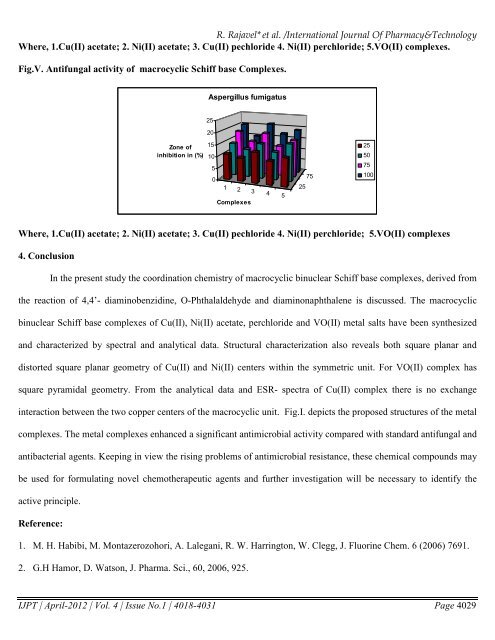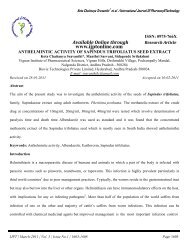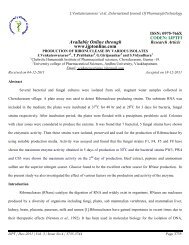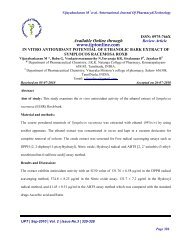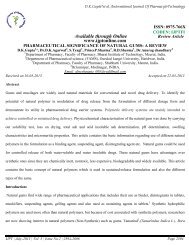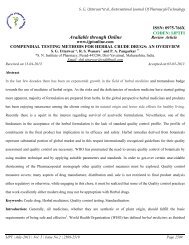Available Online through www.ijptonline.com
Available Online through www.ijptonline.com
Available Online through www.ijptonline.com
You also want an ePaper? Increase the reach of your titles
YUMPU automatically turns print PDFs into web optimized ePapers that Google loves.
R. Rajavel* et al. /International Journal Of Pharmacy&Technology<br />
Where, 1.Cu(II) acetate; 2. Ni(II) acetate; 3. Cu(II) pechloride 4. Ni(II) perchloride; 5.VO(II) <strong>com</strong>plexes.<br />
Fig.V. Antifungal activity of macrocyclic Schiff base Complexes.<br />
Aspergillus fumigatus<br />
25<br />
20<br />
Zone of<br />
inhibition in (%)<br />
15<br />
10<br />
5<br />
0<br />
1 2 3 4 5<br />
25<br />
75<br />
25<br />
50<br />
75<br />
100<br />
Complexes<br />
Where, 1.Cu(II) acetate; 2. Ni(II) acetate; 3. Cu(II) pechloride 4. Ni(II) perchloride; 5.VO(II) <strong>com</strong>plexes<br />
4. Conclusion<br />
In the present study the coordination chemistry of macrocyclic binuclear Schiff base <strong>com</strong>plexes, derived from<br />
the reaction of 4,4’- diaminobenzidine, O-Phthalaldehyde and diaminonaphthalene is discussed. The macrocyclic<br />
binuclear Schiff base <strong>com</strong>plexes of Cu(II), Ni(II) acetate, perchloride and VO(II) metal salts have been synthesized<br />
and characterized by spectral and analytical data. Structural characterization also reveals both square planar and<br />
distorted square planar geometry of Cu(II) and Ni(II) centers within the symmetric unit. For VO(II) <strong>com</strong>plex has<br />
square pyramidal geometry. From the analytical data and ESR- spectra of Cu(II) <strong>com</strong>plex there is no exchange<br />
interaction between the two copper centers of the macrocyclic unit. Fig.I. depicts the proposed structures of the metal<br />
<strong>com</strong>plexes. The metal <strong>com</strong>plexes enhanced a significant antimicrobial activity <strong>com</strong>pared with standard antifungal and<br />
antibacterial agents. Keeping in view the rising problems of antimicrobial resistance, these chemical <strong>com</strong>pounds may<br />
be used for formulating novel chemotherapeutic agents and further investigation will be necessary to identify the<br />
active principle.<br />
Reference:<br />
1. M. H. Habibi, M. Montazerozohori, A. Lalegani, R. W. Harrington, W. Clegg, J. Fluorine Chem. 6 (2006) 7691.<br />
2. G.H Hamor, D. Watson, J. Pharma. Sci., 60, 2006, 925.<br />
IJPT | April-2012 | Vol. 4 | Issue No.1 | 4018-4031 Page 4029


